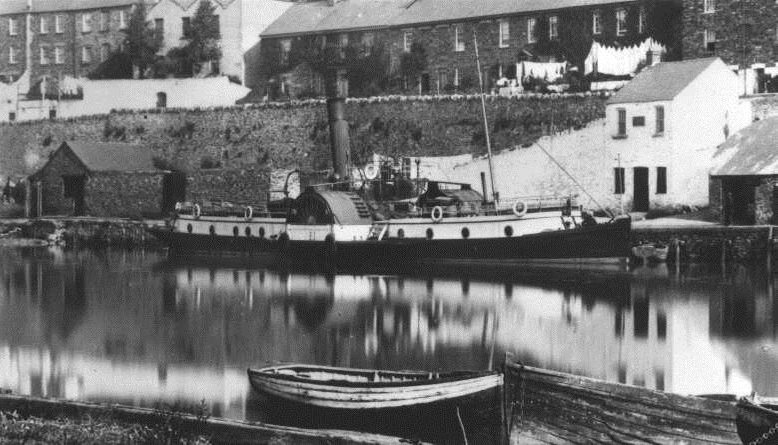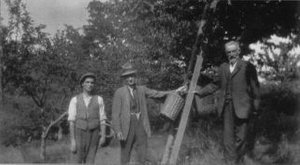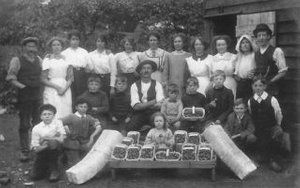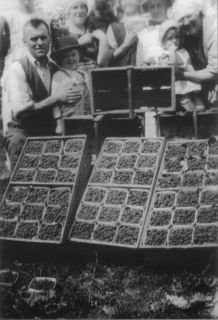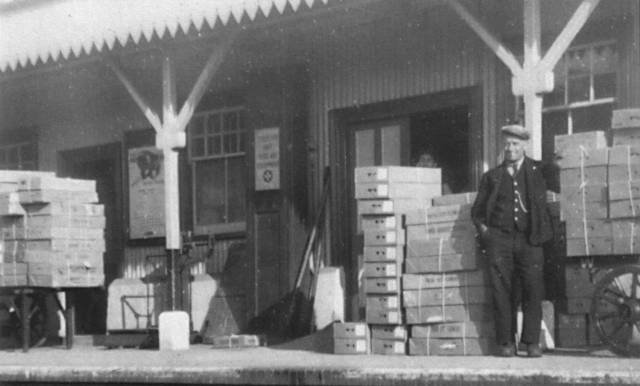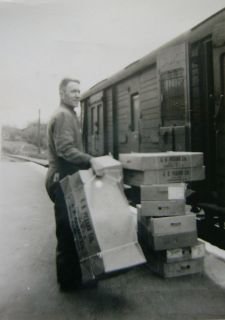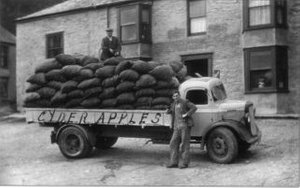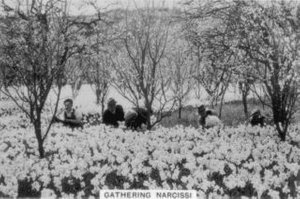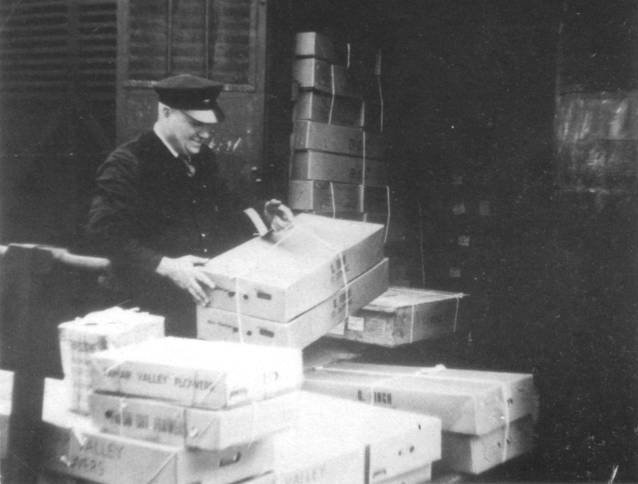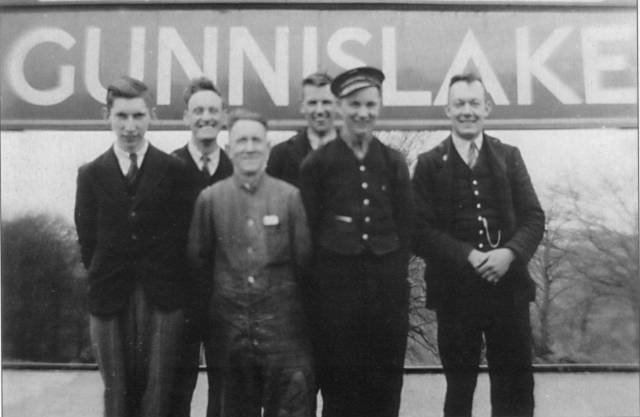Fruit & flower traffic on the Callington Branch
The Tamar Valley is protected from the northeast winds, it has a good rainfall and in summer the southern slopes warm up rapidly reaching a steady temperatures of 70°f. This made the valley an ideal place in which to grow fruit and flowers. Calstock’s ideal south facing location made this area an early producer.
The valley had been famous for growing fruit, cherries and cider apples in large quantities. It is recorded that visitors to the area on river steamers in the late eighteenth and early nineteenth centuries had the impression of travelling through one vast fruit garden. Black Mazzards cherries were native to the area and prized for their early crop. Today, in July each year, at St. Mellion an annual cherry feast is still held.
In 1796 Bere Ferrers was a centre where cherries, pears and walnuts were raised in large numbers. All this production exhausted the land and some corn land nearly went out of cultivation due to the frequent tillage. Market garden land was in little better plight. Nursing the soil back to fertility was a laborious process. This was helped in 1835 by improvements in the grinding machines developed to crush bone to produce bone flour which was used as a fertilizer, when first introduced results were excellent on the phosphate hungry soils. Bone grinding mills appeared on the banks of the Tamar and barges with cargoes of bones imported mainly from France became a familiar sight on the river. There was a mill at Cargreen and at Gunnislake near the Tamar Manure Navigation canal where a paper mill was converted into a bone mill. When the wind was in the right direction the mill could be smelled in Gunnislake. This mill provided fertilizer for the area in the 1870’s and 80’s but by 1905 the mill was derelict.
In the early days the main outlet for produce was the market at Devonport. (Devonport and Plymouth being the only large centres of population). Produce was taken to Devonport by river; there was a regular market steamer from Calstock calling at Cothele Quay, Halton Quay and Cargreen. The service had a regular time (not dependent on tides) as the river was dredged by natural use. The main market boats were the Empress and the Alexandra, both paddle steamers of the the Saltash, Three Towns & District Steamboat Company, Limited
They ran from Calstock to North Corner on Wednesdays, Thursdays and Saturdays. At times the steamer Brunel also carried market products pulling a small loaded boat astern.
The paddle steamer Alexcandrar, pictured here at Calstock, was built by Allsupps, who were well considered builders of small ferries and pleasure steamers. Built in 1888 at 127 tons she sailed from Plymouth on excursion work and had an uneventful career. She was requisitioned in the Great War initially for work delivering market produce from Calstock to Devonport and later for work in Scotland, where she tendered to the Grand Fleet. After the war she returned to excursion work from Plymouth. She was sold in 1927 for scrapping.
In the Tamar Valley many gardens were made from freshly cleared woods, this work was carried out by people like Mr. Joe Parken at Ward, Bere Alston and Mr. Doidge at Hanging Cliff Woods Bere Alston, (between South Hooe and Weir Quay). The soil fertility from this kind of working was soon exhausted and for a cheap bulk manure growers turned to the streets of Plymouth for ‘Dock Dung’. This was laid on the ground at up to 40 ton per acre. There was also seaweed, which added potash. The result was excellent and great quantities of fruit were grown. ‘Dock Dung’ was an evil smelling compound of the sweepings of the Plymouth Streets, fish waste, butchers offal and night soil which was accumulated daily in a huge heap at Pottery Quay, Devonport. Often the dung contained bits of china and this can still be seen in the soil today. It was transported up river in 50ton barges. In the loads sometimes money would be found and the wifes Grand Father once found a purse with money in it and this was enough to pay for that particular load. There were always complaints about the smell and the sanitary authorities stopped the use of ‘Dock Dung’ in 1913. There was no substitute as good ever found. Lime was also especially valuable on recently reclaimed land. Large stocks of lime were held at Halton Quay. There were also a number of Lime Kilns in the valley, many can still be seen, at Weir Quay, Holes Hole, South Hooe, Gunnislake Newbridge, Whimple, Calstock, Cothele, Halton Quay and Ward. Leaves from the river were also collected to place on the land. Mr. V. Nelson from Cothele use to do this.
Some of the early cropping strawberries were Princess Maud, Caroline and Phoebe. In 1883 a new variety Royal Sovereign was grown. This superb variety was planted throughout the Tamar Valley. Large amounts of this fruit were dispatched to London.
Many women worked picking fruit, my mother then Miss Mary Veal a schoolgirl from Gunnislake, circa 1912, worked for Mr. Harris of Whimple picking Strawberries and Raspberries. Raspberries were picked in tubs and mum use to say they use to shrink in the tubs. For this work my mum was paid one shilling a day (5p to day). At Denham Farm, Bere Alston Mr. C. Lansford grew large quantities of fruit requiring around 50 pickers in the season, many came from Plymouth and they would stay for a week at a time being put up in specially built two storey barns, they would return to Plymouth on week ends. After the First World War a virus struck the Royal Sovereign crop and the variety was gradually phased out during the 1920's & 30's. In the late 1930's and early 1940's 'Madame C Le Feve' became the main early variety with Huxleys Grant for mid-season then came Cambridge later known as Vigour In this area these were first grown at Denham Farm, Bere Alston. The Madame C Le Feve strawberry was known by growers as Febe. There has always been a long search for a new plant varieties that were resistant to disease. The industry was helped by the experimental station at Ellbridge near Saltash. Good commercial varieties like, Cambridge, Favourite, Prizewinner and Vigour were grown but these did not have the flavor of the Royal Sovereign. When dispatched fruit would be mainly sent in two pound chip baskets and also in crates containing twelve half pound punnetts.
Pickers of Strawberries would often have carriers with them and when full they would take these carriers to where the fruit had to be weighed. One method of weighing the fruit would be to have a chip and say a 2lb weight on the scales, then on the other side of the scale a empty chip was placed and filled with fruit until the scale tipped.
The Tamar Valley Flower growing started around 1880. Mr. Jackson of Clamoak Farm, Bere Alston displayed in Devonport Market some ‘Double White’ flowers which had been growing at his farm. The ‘Double White’ was a variety of the flower Pheasant Eye. It took some 30 years to get enough bulbs to commence commercial growing of this flower.
The Double White was a beautiful flower, these Narcissi had a lovely perfume. It flowered around the second week in May. It was always a very good seller in the markets.
When I started work at Calstock Station on the 4th April 1949 flowers occupied more acreage then fruit. Flowers became more and more in demand due to birthdays, anniversaries etc. At this time it was estimated some 500 acres were in bulb cultivation. In the 1950's large amounts of Anemones were also grown.
On average in a season around 350.000 packages were dispatched by rail to up country markets. Daffodils started in February, followed by Iris, followed by Double Whites then Strawberries and Raspberries up to early July. Anemones were dispatched September to December. For extra money some would pick primroses to be sent off in small boxes and at times good pocket money could be earned.
At Easter time Mr. Dennis Bolt of GellingsPark, Calstock used to send Airum Lillies in wooden boxes. They were sent to J. V. White of Birmingham. Mr. Bolt had the longest green house in Calstock. Mr. Bolt would bring the wooden boxes to
the station with a small tractor and trailer.
The Railway was no doubt responsible for helping to develop the industry. In the 1950's some £500,000 income resulted for the growers.
The railway provided three loadings for the traffic. The 9.43 from Callington covered traffic to the North Markets, Glasgow, Edinburgh, Newcastle, Manchester, Liverpool, Blackburn, Redcar and Leeds.
The 1.00pm from Callington went to the Midlands, Birmingham, Wolverhampton, Derby, Nottingham, Leicester, Coventry, Chesterfield and Sheffield. The last loadings of the day would be on the 4.23pm from Callington when traffic went to London, Bristol, Newport, Cardiff, Tonypandy and Merthyr Tydfil. Rail vans would be loaded at Gunnislake, Calstock and Bere Alston. Bere Alston would always have the final say as to how the vans would go forward. For example Gunnislake would load a Manchester Van, as would Calstock. It could be there was only enough traffic for one van, the Bere Alston staff would have to transfer and send this van forward.
In the season the stations were extremely busy. At Gunnislake growers would queue out to Sand Hill to unload. At Calstock queues would be back as far as the Chip Factory and at Bere Alston queues would be back up station hill. Traffic had to be loaded 20 minutes before the train departure time.
At this time all the flowers were sent in open bunches whereas to day flowers are sent in bud bunches. Flowers picked in the gardens were taken to packing houses where they were readied for dispatch. Packing houses were built of corrugated iron and wood. Often there would be fires in them; this would help to force the flowers to open but were also useful for tea making and drying wet cloths.
The Southern Railway Staff magazine of September 1949 remarked:-
'The Tamar Valley growers have had a most successful season, both fruit and flowers being heavy. The following dispatched from Gunnislake, Calstock, Bere Alston, Bere Ferrers and Tamerton Foliot.
Number of boxes of flowers sent138228
Number of boxes of fruit sent240564
Passenger Vans dispatched590
Number of special trains run29
All traffic had good transit and those concerned are to be congratulated on the successful result of the efforts to get this highly perishable traffic to the markets in prime condition’.
The above totals do not include produce forwarded from Saltash. This was traffic sent from St Dominic, St Mellion and Landulph. The Railway provided a good service for flowers, produce brought to Calstock at 4.30pm would be on sale in Covent Garden market in London by 4.30am the following day.
The flower boxes containing the open flowers weighed 7lbs each, which meant there were 16 to the 1 cwt (112 lb.) The usual practice would be to tie two boxes together. The size of a box would be 2ft x 6ins. The number of bunches per box depended on the size of the flowers up to 18 bunches were the average number. The variety of flowers was written on the boxes. Anemone boxes were 1ft 6ins x 6ins and weighed 3lbs. The boxes which were supplied by the traders were properly labeled to the appropriate market trader. Some market traders had agents in the area where boxes and labels could be collected. In Bere Alston Curley Jack Sleep was an agent. His shop was opposite the village war memorial. now the site of the Bere Alston history mural.
Flowers boxed and ready for loading at Calstock Station 1955
Traders would also send return empties to the growers. These were free on rail.
Vans use for the Flower and Fruit traffic were all fitted for passenger working and made up of SR PMV’s, GW Siphon G’s, GUV’s, LM and LNER Parcel Vans.
Sending the flowers open meant customers could see the flowers but they would not last as long as today's bud bunches.
The Railway provided special rates for the flowers and fruit traffic. Senders would record their forwarding on a railway consignment note:-
(Example H. H. Down Helston Farm Bere Alston 8 x 16 boxes of flowers to J & E Page, Covent Garden, London.)
When I started on the railway in 1949 traffic for the North and Midlands was routed via Bere Alston to Templecombe and Bath over the old Somerset and Dorset line. When we were transferred to the Western Region traffic was soon routed via Exeter St Davids and Bristol. The WR were anxious that the S & D should close. All transfer points had to be telegraphed with van transfers giving the van numbers and their destinations.
Railway instructions were 'Be Brief Use Code'
An example to Waterloo ( London traffic was delivered by road from Waterloo)
Bere Alston to Waterloo
Tagus 4 40pm Plymouth Friary due yours 3.48am 8.000 packages Covent Garden Market
2100 packages Spitalfields Market
1200 packages Borough Market
Codes were Tagus: Following hence today. Moselle: Give matter special attention. Walnut: Make all necessary arrangements as far as you are concerned.
Station staff would charge the traffic. In 1950 1cwt to London was 10/-. All details were recorded on a Railway Waybill, which was made out in duplicate the bottom copy going to the destination station with the top copy staying at the station. Example ( Bere Alston to Waterloo via Covents No. of boxes 16, Weight, 1cwt to J. E. Page cost 10/- sender H. H. Down. Waybills could take up to 30 entries.
In London there were three markets, Covent Garden, Spitalfields and Borough Market. All London traffic was delivered by road to the markets from Waterloo station (All other destinations traffic was collected by market traders)
Growers were allowed a weekly credit account and bills were sent out on Fridays and would be paid the following week.
When the LSWR opened its station at Bere Alston on the 2nd June 1890 within a month the Company had canvassed growers at St Dominic (on the Cornwall side of the Tamar) to get them to send their products via the LSWR and not take the products to Saltash and the GWR.
The Tavistock Gazette on the 21st July 1893 reported that the LSWR had established a booking office opposite Cothele Quay on the Devon side. St Dominic traffic was ferried across the river by a ferry and taken to Bere Alston station by LSWR horse and wagon. Telegraph communication was set up between the Quay and Bere Alston station in order that loadings could be advised. The Telegraph Poles could still be seen from Helston Farm and Ward up to the 1960's. My wife's mum Mrs. H. H. Down of Helston Farm used one of these poles for part of her washing line.
To assist the local growers in the 1930's the Tamar Valley Growers Association was formed. This was one of the first grower's co-operatives in the U.K. The group took over the old Thomas Westlake's brickworks at Rose Hill. Calstock. Growers had shares in the association and the building became ‘The Chip Factory’, and provided boxes, chip baskets and paper etc. for the growers.
The first manager was Mr. Trevethen who lived at Harewood crossing. Mr. Trevethen was a Naval Reservist and was called up at short notice when the war started in September 1939. Mr. Charles Langsford of Denham Farm, Bere Alston took over as a part time manager because it was important to continue to provide containers to the growers. Mr. John Brown was the Association Secretary.
My memories of the Chip Basket factory are that from the 1950's about 4 times a year 70 - 12 ton wagons would arrive at Calstock for the chip factory. The timber would come from Scandinavia via Plymouth Docks. The station could only deal with 10 wagons at a time; other wagons would be berthed at Bere Alston or Plymouth.
To unload the trunks a ‘Timber Gang’ would come from Plymouth. This would be a mobile crane with driver, an articulated lorry with a trailer with a driver and a porter. The crane would pick up a trunk in the middle with timber dogs and the other two staff would guide it on to the trailer, the load would then be taken to the factory and unloaded on site by the mobile crane and Railway staff. It would take around two weeks to deal with the 70 wagons.
At the factory the bark would be removed by hand. The trunks were cut into 2ft lengths, these were then put into a machine which would peel off thin strips of wood. The strips would then be cut by guillotine to the required length. Sizes approximately were ½lb punnets, 1lb punnets, 2lb Chip baskets and 12lb chip baskets. The sizes mainly used were 2lb chips for strawberries and 12lb chips for cherries and tomatoes and Kidney Beans. A cardboard cover on which the senders name and consignees name were stamped covered the chips.
The chips were made up by girls on piece work (Payment made on each 1000 chips made) Around 50 girls were so employed. The thin wood strips were stapled together and a tin handle was added for the chips. When made the chips had to be dried. In the summer they would be placed in the sun. Winter and wet times there was a special drying room with racks and some would be placed near the furnace which was used to burn up waste matter.
The factory was a former brickworks and was converted to chip basket making in the 1930's. The business was called the ‘Tamar Valley Growers Association’ and was made up of Farmers and Market garden growers. My father inlaw Mr. H. H. Down of Helston Farm, Bere Alston was a shareholder.
Immediately after the war in 1945 Mr. Yeagan was appointed as manager, he was followed by a Miss Taylor. The salesman at that time was Mr. Ron Burnett. The Engineer in charge of the machines was Mr. Len Barrett, his father before held a similar position. The factory foreman was Mr. Tom Walters, assisted by Mr. Hedley Gerry. Mr. A. Howe was also a foreman in later years.
In the early 1950's the factory was sold to Federal Containers Ltd. The Manager was then Mr. Hannah with Mr. M. Sandercock being his assistant. Mr. Sandercock later became the Manager. Not only did the factory supply the local growers but also large quantities were despatched by rail to Evesham, various markets, and the Kent area. The factory was never happy with the railway. The smallest van the railway could supply was a 12-ton covered one. The chips would be loaded to the full but the weight would be less than 1ton. The Railway did not charge for 12 ton but did maintain a minimum charge for 2 ton.
In the 1960's chips started to be dispatched by road, Callington Carriers were one firm used.
When ‘Federal Containers’ took over, the Tamar Valley Growers Association still continued in a smaller way, Mr. Freeman being the manager. They sold Lime, Manure and Garden sundries. In their office worked Miss Bernice Mortimore, Mrs. Sandercock and Mr. Burnett. The deliverymen were Mr. Harold Murray and Mr. Jack Thomas.
With the demise of the railway in the early 1960's under Dr. Beeching most flower and fruit growing ceased and the factory and the T.V.G.A. soon closed. The working girls came from Calstock, Gunnislake, Bere Alston, Chilsworthy, Latchley and surrounding areas. Many travelling by train. Both Mr. Walters and Mr. Gerry lost parts of their fingers cutting wood. Health and Safety was somewhat backward in those days.
To day a houses occupy the old factory site, which is just below Rose Hill Terrace, Calstock.
When the factory first started timber was obtained locally. One source being the Duke of Bedfords woods at Gulworthy, but timber was also obtained from other Woodlands in the U K. During the war Mr. A. Langsford can remember Fir Trees being cut down at Denham Farm, Bere Alston to keep the factory working.
Footnote on Mr. Trevethan
When I worked at Calstock station in the 1950's each Tuesday Mr. Trevethen would receive a basket of fresh fish from Milford Haven. The fish was always due on the 8.24am train from Bere Alston, which arrived at Calstock at 8.30am. Mr. Trevethen would always be there to meet the train and collect his fish. Some times the fish would miss a connection and would not arrive until 10.46 am. Mr. Trevethen would complain re. the missed connection and it would be my job as the junior staff member to deliver the fish to Mr. Trevethen's home near Harewood crossing. I use to walk up the line.
Mr. George Cradick who was one of the valleys largest growers (In one day in 1955 Mr. Cradick sent away 1100 boxes of flowers) gave a lecture in 1957 to the Tavistock branch of the ‘Devonshire Association’ he told the meeting that the Tamar Valley growing area roughly stretched from Gunnislake to Plymouth and included both the Devon and Cornwall banks. At this time there were about 850 independent holdings, which varied in size from one to ten acres. There were approximately 3000 full time employees rising to between 8,000 and 10,000 during the flower and fruit season. Today there is not much left of this once busy industry and the once kept gardens have returned to woodlands and fields but during the spring you can at times still see rows of daffodils and iris.
Planting the Bulbs
A large number of gardens were on steep slopes of the Tamar Valley. This meant the work had to be done by hand. The ground had to be ploughed using a Syracuse Plough, which was driven by a winch at the top of the garden, power being supplied by a motor vehicle. The bulbs were then planted 3 at a time 7ins. apart. A Dibber would be used. The bulbs were planted 6 to 7ins. deep. At times earth had to be brought back to the top of the garden by means of an earth scoop. The help of a winch would also do this work.
After flowering usually in July after the Strawberries had been picked the bulbs would be lifted and sterilised. The Tamar Valley Growers Association at Calstock and Fred Rogers at St. Dominic provided this service.
During the war many gardens were ordered to produce food crops. Flower bulbs had to be dug up and many were thrown onto hedges. Today there is still a lot of evidence of this and in spring time lots of flowers on hedges can be seen. Ministry officials inspected gardens to ensure food cops were produced. Pop Walsh was one such inspector. This did cause certain hardship to the growers and it should not be forgotten the sacrifice which was paid. Also the Railway was not permitted to carry flower traffic.
After the war the industry slowly recovered, for a time growers were allocated quotes to plant bulbs. Dutch salesmen would visit growers. The names of two salesmen were Segar and Piper.
Later growers and farmers planted more level fields where tractors could be used and bulbs could be ploughed in.
This quickened planting and cut down labour. This type of ground tended to produce a crop later than the south facing slopes but earlier varieties of flowers were developed and this to a certain extent compensated for the later ground.
Some flowers on this type of ground were grown in plastic tunnels; also pre-cooled bulbs became more popular this made them flower earlier.
Another feature of the flower season would be telegrams delivered by telegram boys. Some times the price would be good some times not so good. At times growers were advised 'Market Glutted' but flowers were still sent.
The Railway handled flowers and fruit Sunday to Friday. No flowers or fruit were sent on a Saturday because there was no Sunday market.
To many growers it was kind of a cottage industry.
Flower and Fruit growers circa 1950 who dispatched from Gunnislake Station.
Name | From | Name | From |
Jack Bickle O. Beer W. Brewer Fred and Cliff Bratchley Mr. Breen C. Langsford C. Lawrence J. Martin C. Matthews W. & M. Pengelly O. Rich A. Snow D. Stidwell A. Veal and C Veal K. Wearing | Drakewalls Metherell Bittams Hawkmoor Cothele Dimson Farm St. Arms Chapel St. Anus Metherell Sea View, St Anns Harrowbarrow Drakewalls Harrowbarrow Hawkmoor, Gunnislake Albaston | Fern Bray W. H. Harwell S. Jarman A. Knott W. Lesuller W. Langsford W. Lee W. Norrish, W. Perkins A. N. Pengelly J. Rowe D. Steer I. Standing W. Watkins | Metherell Morewell View Whimple Harrowbarrow Gunnislake Metherell Gunnislake Hollow Greep Gulworthy Farm St. Anns Sandock Nurseries Albaston Newlands, Chilsworthy Metherell |
The main growing areas for these senders were,:-
Hawkmoor, Hatches Green, Whimple, Bitthams, North Dimson for Cherries, Albaston, Chilsworthy, Latchley and Metherell, Harrowbarrow.
Flower and Fruit Growers who dispatched from Calstock Station. Circa 1950's.
Name | From | Name | From |
A. Barrett H. Bowden, C Bowden F. Carter J. Cocks George Craddick K. Davey M. Deacon R. Denley Col. Day E. Edwards H. Fletcher J. Goss G. Knight Geo. Mitchell V. Pengelly Fred Rowse Duggie Reid C. Studden G. Start Squance N. Symons N. Trewartha T. Walters | Rosehill
Cothele Villas Rosehill
Station Nurseries
Ravenscourt. HomePark.
Harewood
Danescome
| D. Bolt R. Bratchley G. Cocks Len Crocker W. Chapman D. Davey B. Denley E. Delve H. Easterbrook A. Friendship. N Friendship A. Howe S. Jope H. Loze S. Maunder H. Preston. R Preston. V H K Preston. L. Stone B. Stephens. H. Stephens. D. Stephens C. Studden Fred Studden. Reg Studden G. Striplin L. Southcott H. Treadgold H. Treadgold F. Venning | GellingsPark Harewood Rosehill
Rosehill The Dairy Whimple
Metherell
St Dominic
|
The main growing areas were:-
Harewood, Kelly and Danescome. Mr Stone grew large amounts of Tomatoes and Kidney Beans at Ferry Farm, Harewood.
There were also large amounts of Tomatoes grown in Calstock. It is well known that Calstock Tomatoes have that very special taste
Fruit and Flower Growers who dispatched from Bere Alston Station Circa 1950
Name | From | Name | From |
R. Barrett S. H. Colwill P. Cutts Syd Colwill Mr. Colwill S. Channon H. Dawe M. Drake H. H. Down W. H. Grylls F. Harris A. Hicks Mr. Jackman W. H. Langman P. Landers H. Miller J. Martin V. Pomroy H. Plumb R. Parken S. M. Sleep Howard Sherrell L. J. Spurrell Major Woolcombe W. Williams | North Ward
Newquay, Morwellham
Tuckermarsh Cotts Helstone ( My wife’s dad ).
Morwellham
Rumleigh
Lea Farm Ward
Lower Birch
Rumleigh Weir Quay | E. Blandon W. Crossman H. Creaber W. H. Champernowne, H. Cole A. Dawe Fred Dawe Eick and Langman G. Grylls B. Gumb E. Heard N. Honey W. Johnson A. Langsford L. Luke Mr. Maynard Capt. O'Leary W. R. Pengelly W. Peters F. J. Richards Harold Sherrell W. Schutcatter C. K. Weaving A. Webber A. Whining | Cotts
Yelverton Kingwell Tuckermarsh
Weir Quay
North Hooe Denham South Ward Tuckermarsh MountTamar Penarth Morwellham Bickham Higher Birch
Lockridge
|
The main growing areas were:-
Tuckermarsh, Rumleigh, Ward, North Hooe, South Hooe, Clamoak and Denham
Fruit and Flower growers who dispatched from Bere Ferrers Station circa 1950's
Name | From | Name | From |
C. Friend L. Jury J. Pedler | N. Grills R. Jackson | Hoopper Bros |
Bill Hingston loading Tamar Valley flowers at Saltash Station circa 1930’s
Large amounts of Fruit and Flowers were sent from St Dominic, St Mellion, Pilliton and Landulph. This produce was dispatched from Saltash Station on the G.W.R. Fred Rogers carted a lot of this traffic by lorry to Saltash.
Some of the growers from this area were:-
V. Nelson, M. Crowell, E. Walsh, E. Gale, E. Rickard, L. Hughes, S. Congdon, A. Jope, W. Downing, D. Cooper, Joe Snell, S. Tink and Walter Dark, Main growing area:- Brentswood and Halton Quay.
Also in the valley fairly large amounts of Plumbs, Gooseberries, Damsons, Red, Black and White currants were grown. These were mainly sold locally.
Also there were lots of Apple trees in the valley and in the season apples were dispatched in open wagons from Gunnislake station to Whiteways of Whimple for cider.
There were also Pear trees.
Details of Markets where the Flowers and Fruit were sold
London Covent Garden | Bradford |
John Austin. D. Busby N. R. Cole A. Goodchild G. Munro J. and E. Page Ridley and Houlding F. J. Barker | Broome and Green J. Collinridge Fenn and Hexton D. Ingamells W. Newton D. Pankhurst Skells and St. Croix | ||
London Borough | London Spitafields | ||
W. Blackman | F.J. Barker | ||
Liverpool | Manchester | ||
T. J Poupart F T Waterworth G. Collins | James Blackburn J. Thwaites Everson W. J. Litherland J. Warburton Somers and Gibson Egar Rae W. Shaw R. C. Cole |
Bradford | Birmingham |
Fyfes Collins H Brook | J. V. White F Nicholls G. Jackson H Hyde |
Blackburn | Bristol |
Somers and Gibson. | Crocker and Williams Mark Blooms |
Coventry | Cardiff |
J. McCutchion | W. Morgan |
Edinburgh | Glasgow |
James Lindsay & Son | McCraig and Webb |
Gateshead | Leeds |
Mack and Bird | J. Wood |
Nottingham | Penzance |
Len Baxter | H. Boase |
Sheffield | Redcar |
J.C. Lucas | Longslade Ltd. |
Traffic would also be sent to Traders at Newcastle, Wolverhampton, Derby, Newport and Swansea.
Daffodils grown by my Father in Law Mr. H. H. Down (1930/40) were Emperor, Ornatus, Horace, Pheasant Eye, Sir Watkin and Victoria. There were many other varieties grown in the m and these included, Actea, Barri, Golden Spur, King Alfred, Princep, Bath Flame, Cheerfulness, Double White and Carlton.
John Snell is the young man on the left of the group in this 1950 photograph
Much of this paper is from my memories when I worked at Calstock, Gunnislake and Bere Alston Railway Stations. I have also referred to Frank Bookers book ‘The Archaeology of The Tamar Valley’ and I acknowledge the excellent help of Mr. Alan Langsford of Denham Farm, Bere Alston and Mr. Walter Dark of St. Mellion Flowers.
John Snell, Bere Alston
